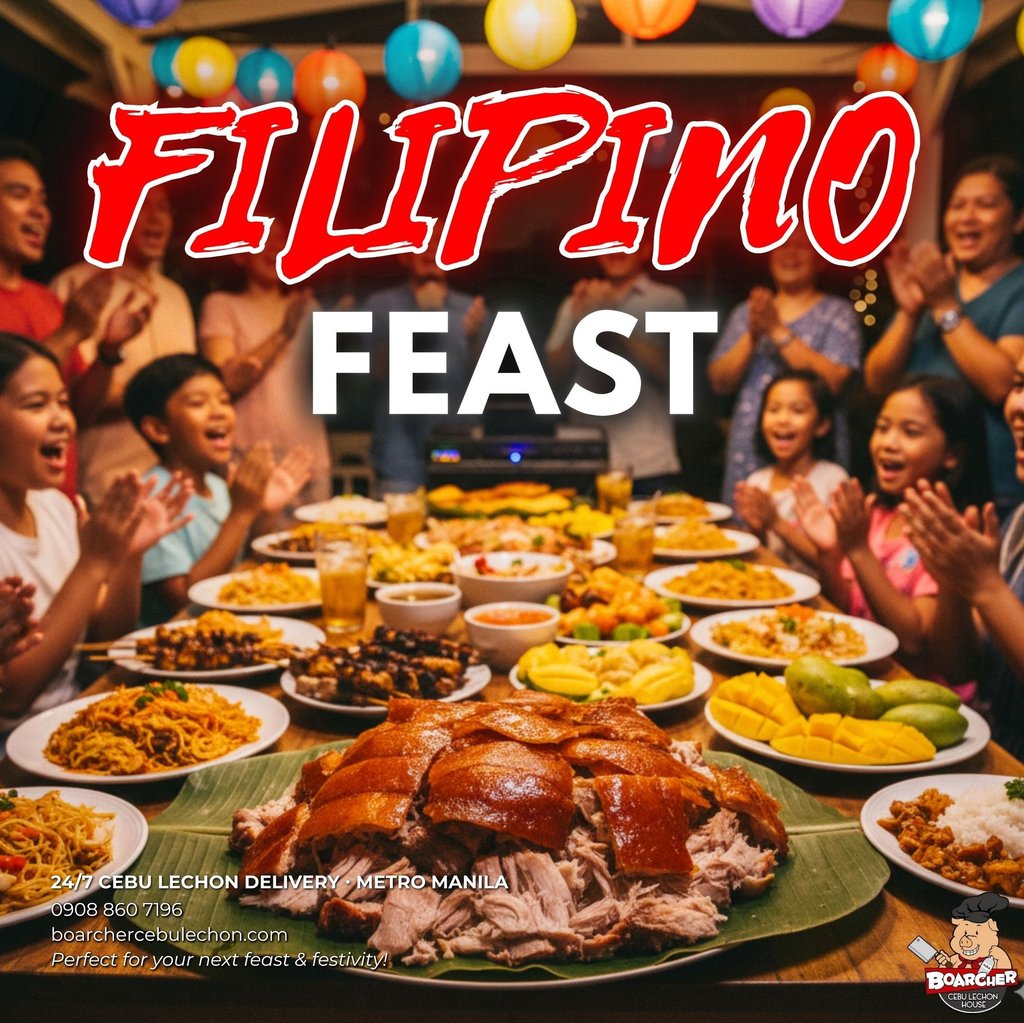Exploring Filipino Culture and Lechon
LECHONLECHON BABOYCEBU LECHON
9/20/20257 min read


Introduction to Filipino Culture
Filipino culture is a vibrant tapestry woven from a multitude of historical influences, reflecting a unique blend of native traditions and foreign elements. The Malay origins of the Filipino people establish a foundational cultural framework, enriched by centuries of interaction with Spanish colonizers, American governance, and Chinese traders. This historical layering has created a rich cultural identity that is both diverse and dynamic.
At the core of Filipino culture are strong family values, where familial bonds serve as the cornerstone of social structure. Families in the Philippines often extend beyond the nuclear unit, encompassing a wide network of relatives. This broad definition fosters a communal approach to life, where support and cooperation among family members are paramount. The concept of 'Bayanihan' exemplifies this spirit, where neighbors unite to help one another, particularly in times of need, underscoring the Filipino emphasis on community solidarity.
Religion also plays a significant role in shaping Filipino cultural norms, with the majority of the population being Roman Catholic. This strong religious inclination influences daily life, celebrations, and various cultural practices, such as the observance of fiestas in honor of patron saints. Spirituality intertwines with tradition, guiding interactions and cultural expressions throughout the archipelago.
Additionally, unique customs and practices, such as traditional dances, music, and cuisine, contribute to the rich tapestry of Filipino culture. Each region boasts its distinct identity shaped by its historical influences and local traditions. Thus, exploring Filipino culture reveals a captivating narrative of resilience, adaptability, and an enduring sense of community, defining the Filipino identity in a global context.
The Significance of Food in Filipino Culture
Food occupies a central role in Filipino culture, transcending mere sustenance to become a vital component of social interaction and community bonding. In the Philippines, meals are not just about eating; they are events that foster relationships and create lasting memories. The traditional Filipino dining experience emphasizes communal eating, where families and friends gather around a table, sharing dishes that reflect the rich culinary heritage of the archipelago.
Celebrations, whether they are milestones like birthdays, weddings, or festivals, often feature lavish feasts that showcase an array of regional specialties. Lechon, a roasted whole pig, stands out as a hallmark of festive occasions, symbolizing abundance and hospitality. Its preparation and consumption signify not only the joy of the event but also the efforts to bring people together. This practice of sharing meals reinforces the Filipino value of *Bayanihan*, or communal unity and cooperation.
Moreover, the importance of food extends to day-to-day life. Typical Filipino meals often consist of staples such as rice, vegetables, and meat, prepared in various ways that highlight regional ingredients and cooking techniques. The dining experience frequently adopts a hospitable nature, where guests are treated with the utmost respect and are often encouraged to take more than enough food. This hospitality reflects the deep-rooted cultural norms that prioritize communal well-being and the nurturing of relationships.
Culinary practices in the Philippines are often interlaced with cultural narratives, history, and local traditions, emphasizing the role of food as a cultural bridge. By participating in shared meals, individuals deepen their connection to their heritage, illustrating how food functions as a conduit for cultural expression and continuity. Through every gathering and feast, Filipino food not only nourishes the body but also serves to cultivate the spirit of community and togetherness.
Lechon: The Filipino Icon
Lechon holds a venerable place in Filipino culinary traditions, revered not only for its distinctive flavor but also for its cultural significance. This savory, roasted pig, characterized by its crispy skin and succulent meat, often takes center stage during festive occasions, such as birthdays, weddings, and various regional celebrations. In these contexts, lechon serves as a more than just a dish; it is a symbol of joy, abundance, and community. Its presence at gatherings signifies unity and shared experiences, showcasing the essence of Filipino hospitality.
The origins of lechon can be traced back to the country’s diverse influences, including indigenous practices and the culinary techniques brought by Spanish colonizers. It reflects a history of blending flavors and techniques, which have evolved over generations. In the Philippines, especially in regions like Cebu, lechon has garnered widespread acclaim. Cebu lechon, often noted for its intricate marination and cooking methods, is considered some of the best in the world, with chefs emphasizing the importance of the preparation process. Cooking lechon involves marinating the whole pig with a mixture of herbs and spices, followed by slow-roasting over open flames for several hours, resulting in a dish that tantalizes the palate.
Festivals and Lechon: A Culinary Highlight
In the vibrant landscape of Filipino culture, festivals play an essential role in expressing community spirit and shared values. Among the myriad of celebratory traditions, lechon stands out as a culinary highlight, symbolizing festivity and abundance. This prized dish, consisting of a whole roasted pig, is a staple at various gatherings, including fiestas, weddings, and birthdays, reinforcing its significance in Filipino culinary traditions.
Fiestas, a cornerstone of Filipino culture, are perhaps the most notable occasions where lechon takes center stage. These local celebrations, held in honor of patron saints, are characterized by lively street parades, traditional music, and, importantly, an array of sumptuous feasts. The preparation of lechon for fiesta celebrations involves meticulous methods, often incorporating various regional flavors, which enhance the delectability of this iconic dish. As families prepare for these festivals, invitations to share a meal featuring lechon symbolize hospitality and community unity.
Additionally, weddings in the Philippines are grand affairs, and the presence of lechon is almost indispensable. This delicacy is not only a treat for the palate but also represents prosperity and fertility for the newlyweds. The sight of a perfectly roasted lechon at a wedding reception evokes a sense of joy and celebration, as family and friends gather to partake in the couple's special day. Notably, birthdays also commonly showcase lechon, emphasizing its role as a dish that brings people together during personal milestones.
Specific festivals, such as the famed Sinulog in Cebu and the Pahiyas in Quezon, are renowned for their vibrant displays and abundant food offerings, with lechon being a featured centerpiece. These occasions exemplify the deep connection between Filipino culture and culinary traditions, showcasing how the communal aspect of sharing lechon fosters a sense of belonging and festivity among participants. Thus, lechon emerges as more than just food; it embodies the spirit of celebration that transcends mere nourishment.
Regional Variations of Lechon
Lechon, a cherished dish deeply rooted in Filipino culture, exhibits a fascinating variety of preparations and flavors across the different regions of the Philippines. Each area brings its own unique touch, reflecting local ingredients, cooking methods, and cultural influences. This diversity not only highlights the regional culinary expertise but also enhances the experience of enjoying this iconic delicacy.
In the Visayas, particularly in Cebu, lechon is famously known for its distinct taste. It is typically marinated with a mixture of herbs and spices, infusing the meat with rich flavors. A hallmark of Cebuano lechon is the tasty meat and crispy skin, achieved through cooking techniques that involve slow-roasting over charcoal. Cebuanos take pride in the way they prepare their lechon, often serving it at significant celebrations and gatherings, making it a centerpiece at festivities.
On the other hand, in Luzon, especially in Batangas, lechon kawali offers a different take. While lechon kawali is primarily a deep-fried dish made from pork belly, it shares the same love for crispy skin. Batangueños incorporate local spices, resulting in a rich savory flavor that appeals to many. This variation demonstrates how even a similarly named dish can undergo transformation based on regional preferences and available resources.
Meanwhile, in Mindanao, lechon is influenced by various cultural practices. The use of spices such as lemongrass and various types of local chilies sets this version apart. It is often served during special occasions like weddings and communal events, reinforcing the importance of lechon in social gatherings across the archipelago.
The regional variations of lechon illustrate how Filipino culinary practices are woven into the fabric of local cultures. From the marination methods to the choice of herbs and spices, each region tells a story of its people, traditions, and palate, showcasing the rich tapestry of Filipino cuisine that continues to evolve over time.
Modern Trends and Innovations Around Lechon
Lechon, the iconic roasted pig synonymous with Filipino celebrations, has evolved significantly in recent years as culinary preferences shift and modernization takes hold. Contemporary trends reflect not just innovation in cooking methods, but also a broader embrace of fusion cuisine. As chefs experiment with various culinary influences, lechon has recently seen creative adaptations that incorporate flavors and techniques from diverse gastronomies, enhancing its appeal beyond traditional boundaries.
One notable trend is the integration of global flavors into lechon preparation. Chefs are introducing ingredients such as Korean gochujang or Mexican adobo into the marinade, producing innovative flavors that cater to a broader, increasingly adventurous palate. These fusion dishes not only attract local consumers but also make lechon an appealing option for international culinary enthusiasts. Menu offerings in both restaurants and catered events reflect this evolution, showcasing lechon served with unique accompaniments such as homemade sauces inspired by international cuisine.
The influence of social media cannot be overemphasized in terms of shaping food culture around lechon. Social platforms serve as vibrant venues for food photography and sharing experiences, which have sparked interest in traditional dishes among younger generations. This connectivity enables the promotion of lechon on a global scale, with trending hashtags and viral posts inspiring individuals to seek out and experience this Filipino delicacy, thus broadening its market potential. Moreover, food bloggers and influencers frequently highlight innovative lechon recipes, further establishing the dish’s position as a food trend beyond the Philippines.
The passion for experimentation and the push for creativity have led to more environmentally conscious cooking methods as well. Chefs are exploring sustainable sourcing and preparation techniques, integrating local ingredients that lessen waste and boost nutritional value. Overall, the evolution of lechon illustrates a vibrant interplay between tradition and modernity, maintaining its status as a beloved cultural staple while resonating with contemporary culinary trends.
Conclusion: The Ties that Bind Filipino Culture and Lechon
Lechon, the iconic Filipino roasted pig, stands as a testament to the rich tapestry of Filipino culture. Its significance transcends mere culinary delight; it embodies the spirit of Filipino identity and traditions. Rooted in long-standing customs, lechon brings families and communities together during celebrations, marking milestones such as birthdays, weddings, and holidays. The act of preparing and sharing this dish does not simply nourish the body; it nourishes the soul, reaffirming familial bonds and communal ties.
In contemporary society, while modern influences shape the culinary landscape, the role of lechon remains vital. Filipino food continues to evolve, yet the way lechon is integrated into communal events is a powerful reminder of how tradition can coexist with innovation. Many Filipinos abroad strive to recreate the traditional cooking process, ensuring that the flavors and experiences associated with lechon are preserved, regardless of geographical boundaries. This endeavor reflects the importance placed on maintaining cultural heritage, highlighting food as a unifying force that nurtures a collective identity.
As globalization molds various cultures, the Filipino commitment to celebrating their culinary symbols, like lechon, illustrates a dedication to heritage. It serves as an emblem of resilience, showcasing how the Filipino community embraces both their traditions and the modern world. Thus, lechon represents more than a dish; it is a narrative that encapsulates the heart and soul of Filipino culture, connecting individuals across generations and distances. Through these shared culinary experiences, the essence of Filipino identity remains intact, preserving the intricate relationship between food and culture for generations to come.
24/7 CEBU LECHON DELIVERY
Authentic 24/7 Cebu Lechon delivery service in Greater Metro Manila.
Join our email newsletter for exclusive freebies ∙ promos & discounts!
Contact us
© 2025 All rights reserved


"COMPLETE YOUR FEAST WITH BOARCHER"
